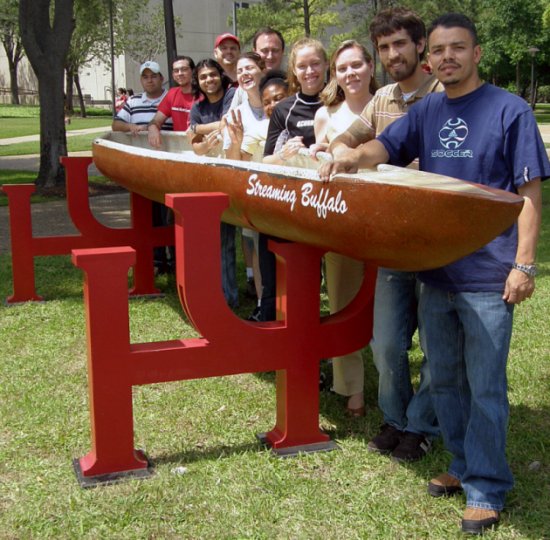Concrete Canoe
Today, we build our boat from concrete. The University of Houston's College of Engineering presents this series about the machines that make our civilization run, and the people whose ingenuity created them.
A civil engineering colleague stopped me three days after the Virginia Tech. murders. His students had won the regional concrete canoe competition two days before it -- and he was beaming. Only then did the terrible event in Virginia really sink in. Let me explain:
 He took me off to see the winning canoe, and we met some of the fifty students who'd worked on this large project. What a neat bunch! I wanted a photo the canoe for this program's web site, so they took the canoe off its dolly and set it up in the yard. And I realized that I was watching much more than just a canoe.
He took me off to see the winning canoe, and we met some of the fifty students who'd worked on this large project. What a neat bunch! I wanted a photo the canoe for this program's web site, so they took the canoe off its dolly and set it up in the yard. And I realized that I was watching much more than just a canoe.
These young men and women hefted their 260-pound creation with an ease that reflected honed teamwork and mutual trust. That's when the naked horror of those killings hit me -- it might've been them. But enough of that; we're here to talk about concrete boats.
Competing canoes, built from concrete, have been a staple in civil engineering schools since the 1970s. That exercise serves many functions. Perhaps the most obvious is revealing how engineers produce the unexpected. Beyond that, those fifty students had learned so much about: composite materials, computer aided structural design and stress analysis, fluid dynamics, esthetics, athletics, project management, and fundamental self confidence.
Concrete canoes are not nearly as bizarre as they might sound. This one was made from layers of a special concrete that's just a tad denser than water. The layers are laid on a polystyrene frame with a layer of wire mesh in the middle. The concrete is further reinforced with a scattering of thin steel staples. The result is a long, graceful, five-person canoe. Its walls are half-an-inch thick, and a couple of small Styrofoam plugs are molded in the bow and stern to keep it from sinking, should it be swamped.
This is much more than a fantasy exercise. You've driven across floating concrete bridges. And it's a surprise -- how many practical concrete boats and ships have served us over the years.
Two of the earliest concrete boats were a pair of dinghies built in France in 1848. After that, many barges, and a few ships, were made from concrete. The Norwegians built a concrete ocean-going vessel in 1917. We built twelve concrete ships during WW-I, when steel was scarce. I remember the 24 McCloskey-class concrete cargo ships we built late in WW-II for the same reason.
Concrete is an ancient synthetic composite material -- a matrix with embedded particles that strengthen it. (Bone and wood are naturalcomposites, by the way.) Today, we routinely use composites that're lighter and stronger than steel (although steel itself is a composite, an iron matrix laced with carbide particles.)
So, each year, students around America try to take this particular composite to some new level. And I spent an extraordinary half hour yesterday with this group who'd done something special. And, having done so, knew they could -- and would -- do so again.
I'm John Lienhard, at the University of Houston, where we're interested in the way inventive minds work.
For more on composite materials, see https://en.wikipedia.org/wiki/Composite_material
For more on concrete ships: http://www.concreteships.org/ships/
I am grateful to Ted Cleveland, UH Civil Engr. Dept., for his and his student's extensive counsel. Photos by JHL.

Above: part of the team with their canoe, left to right: Carlos Zepeda, Scott Dawson, Manan Bhalja, Jason Krog, Larissa daCosta, Wade Barnes, Vanessa Aririguzo, Ashleigh Williams, Beth Heeb, Robert Peterson, Jose Velasquez